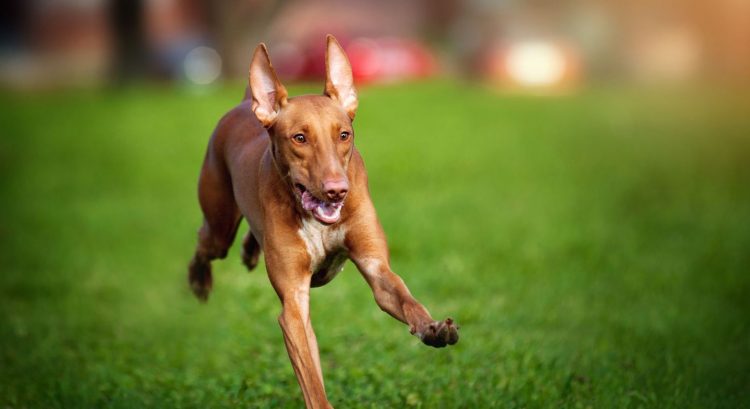
Hound
45–55 lbs.
23–25 in. (male)
21–24 in. (female)
12–14 years
1. Key Characteristics
Pharaoh Hounds are powerful, fast sighthounds who originated in Egypt. The breed is also the national dog of Malta.
They have wedge-shaped heads; small, amber-colored eyes; medium-sized, erect ears and a nose that’s usually the same color as the coat. The tail is thicker at the base and tapers toward the end.
The short, glossy coat sheds little and comes in shades of tan, chestnut and red golden. White markings may appear on the tail, chest, feet and face. The nose and ears can change color to a rosy hue when the dog is excited, and this is possible because of the absence of black pigment.
2. Where They Came From
The Pharaoh Hound’s roots can be traced to 3000 B.C. in Egypt, although the Pharaoh Hound Club of America dates the origin to 4400 B.C. Egyptians treasured the dog’s excellent hunting abilities and loyalty.
The dogs were brought to Malta by traders and bred for 2,000 years with the breed standard preserved. The Pharaohs we see today are nearly identical to the original dogs.
Pharaohs appeared in England in the 1930s, but evidence of this is lacking. Later records indicate a Pharaoh was brought to England in 1967, while the first Pharaoh arrived in the United States in 1967.
The American Kennel Club added the breed to its Miscellaneous Class in 1979. The breed was then moved to the Hound Group in 1983.

3. How Friendly Are They?
Pharaohs are smart, playful and affectionate dogs. They are easy to train when using positive reinforcement; negative reinforcement can cause the dog to shut down or become unresponsive to commands.
Other dogs are usually pals, but Pharaohs may try to dominate them. Cats are fine when the cat and the dog are raised together; adult cats and Pharaohs have been known to get along with proper introduction, but supervision is always recommended. Pharaohs love children but can be reserved with strangers.
Pharaohs make good watchdogs because they often bark at a new sound or movement. These dogs are attached to their family members, so they are not recommended as outdoor-only dogs.
4. Is This the Right Dog for You?
Exercise Needs
HIGH: These active, high-energy dogs need daily walks and playing, and many also enjoy jogging. When outdoors, Pharaohs should be kept on a lead or exercised in an enclosed area because of their extremely high prey drive. If they give chase, they can be difficult to catch since they are such fast runners.
They can do well in apartments if they are sufficiently exercised. A yard would be appreciated, but it needs to have a tall fence (6 feet high is recommended).
Grooming Needs
LOW: Pharaohs shed little and are usually a good breed for people with allergies. They can be cleaned with a damp cloth occasionally.
Pharaohs are clean dogs with a short coat; regular bathing is unnecessary and should be done only as needed. Regular maintenance of the teeth, ears and nail filing should be done regularly.
Health Problems
LOW: There are no known specific illnesses associated with the genetics of a Pharaoh.
Watch this excited Pharaoh dog play with a Bengal cat:

5. Where to Adopt One?
Start with our dog search to find a Pharaoh Hound near you. Shelters and rescues are good places to check first, too, and you can also contact a regional representative of the Pharaoh Hound Club of America’s rescue team.
If you work with a breeder, make sure their pets are well cared for, and ask to see the parents of the dog or puppy you are considering.








